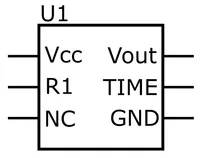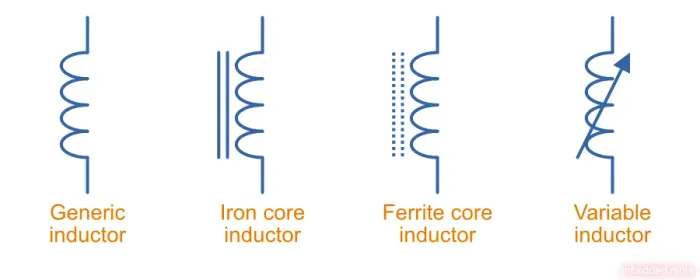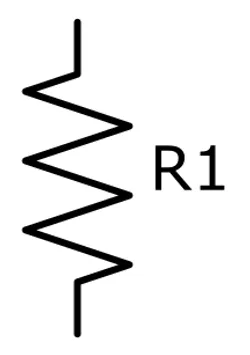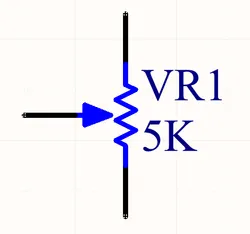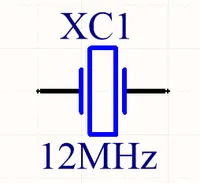Component Schematic Symbols and Designators
Component designators and schematic symbols are used to quickly identify components both on schematics and PCBs. They usually consist of a short acronym representing the type of component, followed by unique number to distinguish it from other components of the same type (e.g. R3, R4, C3).
Over the years, many standards have been released that specify particular designator prefixes for component types. These include:
- Australian Standard AS1102:1995 (Graphical symbols for electrotechnology)
- IEC 60617
- IEEE 315-1975.
However, many schematic and PCB silkscreen designs do not strictly follow any standard (although the similarities are usually quite high). The following list shows non-standard specific, commonly used acronyms and the type of component they represent.
List of Common Component Designators And Symbols
Sorted by alphabetic order.
Antennas (ANT)
There are a number of different schematic symbols for an antenna, but they all look similar and should be easily recognizable. The designator E is also used, however ANT is my personal preference.
Designator(s):
ANT(recommended)E
Recommended schematic symbols(s):
Assemblies (A)
Separate assembly or sub-assembly (e.g. daughter board). I do not see this designator used much in practice (and I myself have never used it, for things such as GPS modules with an LGA footprint I have always used the designator U).
Recommended designator(s):
A
Batteries (BT)
The designator BT is commonly used for a battery. The schematic symbol shown below is typical for a battery, although sometimes the distinction between a single-celled and multi-celled battery is made. If the battery is single-celled, this can be represented by a symbol with only one pair of long/short lines (representing the two electrodes of the cell). If the battery is multi-celled, two pairs of long/short lines with a dotted line connecting them (representing many plates) can be used. I prefer to just use the below symbol for any battery type.
Recommended designator(s):
BT
Recommended schematic symbol(s):
Capacitors (C)
C is the recommended designator for capacitors (both polarised and non-polarised). Sometimes you will see VC used for a variable capacitor (these are not common). I recommend using two different schematic symbols, flat plates for a non-polarised capacitor, and one plate which is curved for a polarised capacitor.
Recommended designator(s):
C
Recommended schematic symbol(s):
Recommended parameters to show on the schematics:
- Capacitance (e.g.
10uF) - Voltage (e.g.
16V)
For special high tolerance (e.g. 1% or less) capacitors it can be useful to show the tolerance also.
Diodes (D)
The designator D can be used for most diodes. Sometimes Z is used for a Zener diode, and LED for a light-emitting diode, however TVS, Schottky and general purpose diodes are still just D.
Recommended designator(s):
D
Recommended symbol(s):
Fuse/Fuse Holders (F, XF)
F is the designator used for fuses (wired, electrical, e.t.c). XF is commonly used for a fuse holder.
Recommended designator(s):
F(fuse)XF(fuse holder)
Recommended symbol(s):
Ferrite Beads (FB, FEB)
Designator(s):
FB(recommended)FEB
Schematic symbol(s):
Recommended parameters to display on the schematic:
- Impedance (typically rated @ 100MHz)
- Max. current
Read more about ferrite beads here.
Fiducials (FID)
Recommended designator(s):
FID
Recommended schematic symbol(s):
Gas Discharge Tubes (GDT)
Recommended designator:
GDT
Recommended schematic symbols(s):
Read more about GDTs here.
Ground (GND, AGND, DGND)
Sometimes GND is used for all ground points, and sometimes grounds are split based on noise boundaries such as AGND and DGND (this is common in high-frequency circuits).
Designator(s):
GND: For general purpose use.AGND: Specialised analogue ground.DGND: Specialised digital ground.
Schematic symbol(s):
Integrated Circuits (U)
U is the designator for integrated circuits. ICs include microcontrollers, liner voltage regulators, op-amps, e.t.c.
Why U? One theory is that U was the the designator for anything “Unspecified”. It makes sense that when ICs first came into use that they would of been labelled as such. The name stuck, and now U is used for ICs (and no longer for anything “unspecified”). Another theory is that U stood for “Unrepairable”1.
In older schematics you may also see IC or Z used for integrated circuits.
Recommended designator(s):
U
Recommended schematic symbol(s):
Jack (J)
A jack/socket/female connector. Also defined in IEEE 315 as the least moving part of a connector set (which also includes a plug, P).
Recommended designator(s):
J
Jumper (JP)
Jumper or link (L is for inductor, not link). This maybe a simple piece of wire, a physical jumper component, or perhaps a (0\Omega) resistor).
Recommended designator(s):
JP
Inductor (L)
L is used as a designator for inductors. This is probably in honour of the physicist Heinrich Lenz who was a pioneer in the discovery of electromagnetism (and because I is commonly used to represent current).
Recommended designator(s):
L
Recommended schematic symbol(s):
Motor (M)
Recommended designator(s):
M
Mechanical Part (MP)
A mechanical part. This is an umbrella term for many different things, such as screws, standoffs, brackets, e.t.c.
Recommended designator(s):
MP
Plug (P)
A plug/male connector. Also defined in IEEE 315 as the most moving part of a connector set (which also includes a jack, J).
Recommended designator(s):
P
Photovoltaics/Solar Panels (PV)
PV is the designator for photovoltaics (aka solar panels).
Recommended designator(s):
PV
Resistors (R, VR)
Sometimes you will see LDR for light-dependent resistors. For more info see the Resistors page.
Recommended designator(s):
R: Standard 2-pin resistorsRN: Resistor networks (more than one resistor in the same package, sometimes sharing a common connection).VR: Variable resistors (aka potentiometers or rheostats). I have seen the reverse,RVis use before, along withPOT.
Recommended schematic symbol(s):
Switches (S, SW)
S is the designator used for a switch. SW is also commonly used. Sometimes you will see switches labelled according to their type (e.g. PB for push-button switches, DPDT for double-pole double-throw switches), but this is not recommended.
Recommended designator(s):
S
Spark Gap (SG)
Recommended designator(s):
SG
Recommended schematic symbol(s):
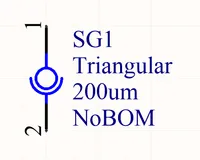
Transformer (T)
Designator(s):
T(recommended)TF(2)
Transistors (Q)
Typically, Q is used for all transistors, no matter if they are BJTs, MOSFETs, JFETs, e.t.c.
Designator(s):
Q(sometimesQis also used for an integrated circuit, but I prefer usingU)
Recommended schematic symbol(s):
Test Point (TP)
Test point. These may be physical components on the PCB, or just places of exposed copper (e.g. pads, holes or vias).
Recommended designator(s):
TP
Wire/Cable (W)
Wire/cable.
Recommended designator(s):
W
Crystals/Oscillators (XC, XTAL, Y)
Timing crystals. XTAL or Y are also used.
Recommended designator(s):
XC
Recommended schematic symbols:
Varistors (RV)
Designator(s):
- RV (recommended)
Schematic symbols:
Regex
The regex pattern to match any valid component designator, which is one or more capital letters followed by one or more numerals, is:
^[A-Z][A-Z]*[0-9][0-9]*$The above pattern also contains the start and end-of-line anchors ^ and $, to enforce that there is no text before or after the designator. These can be removed if desired. More on using regex with component designators can be found on the Altium Scripting page.
Footnotes
-
https://electronics.stackexchange.com/questions/25655/why-is-u-used-for-ics-on-circuit-diagrams, fetched on 2019-05-03. ↩
-
RF Cafe. AN (Army / Navy) Component Designators & Designations. RF Cafe. Retrieved 2021-07-06, from https://www.rfcafe.com/references/electrical/an-component-designators.htm ↩


